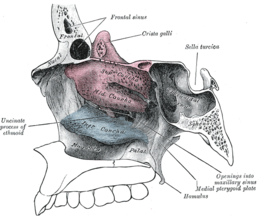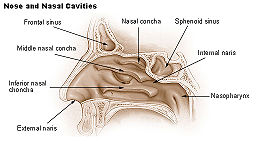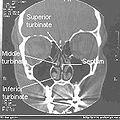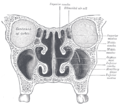- Nasal concha
-
Nasal concha 
Lateral wall of nasal cavity, showing ethmoid bone in position. (Superior and middle in pink, and inferior in blue.) 
Latin conchae nasales MeSH Conchae+Nasales In anatomy, a nasal concha (or turbinate) is a long, narrow and curled bone shelf (shaped like an elongated sea-shell) that protrudes into the breathing passage of the nose. Turbinate bone refers to any of the scrolled spongy bones of the nasal passages in vertebrates. [1]
In humans, the turbinates divide the nasal airway into four groove-like air passages, and are responsible for forcing inhaled air to flow in a steady, regular pattern around the largest possible surface of cilia and climate-controlling tissue.
Contents
Structure and functions of turbinates
Turbinates are composed of pseudostratified columnar, ciliated respiratory epithelium with a thick, vascular, and erectile glandular tissue layer. [2] The turbinates are located laterally in the nasal cavities, curling medially and downward into the nasal airway. Each pair is composed of one turbinate in either side of the nasal cavity, divided by the septum.[2]
The inferior turbinates are the largest turbinates, and can be as long as the index finger in humans, and are responsible for the majority of airflow direction, humidification, heating, and filtering of air inhaled through the nose.[1]
The middle turbinates are smaller. In humans, they are usually as long as the little finger. They project downwards over the openings of the maxillary and ethmoid sinuses, and act as buffers to protect the sinuses from coming in direct contact with pressurized nasal airflow. Most inhaled airflow travels between the inferior turbinate and the middle turbinate.[1]
The superior turbinates are smaller structures, connected to the middle turbinates by nerve-endings, and serve to protect the olfactory bulb. NTLS 160[1]
Role of turbinates in the respiratory system
The turbinates compose most of the mucosal tissue of the nose and are required for functional respiration. The turbinates are enriched with airflow pressure and temperature-sensing nerve receptors (linked to the “trigeminal” nerve route, the fifth cranial nerve), allowing for tremendous erectile capabilities of nasal congestion and decongestion, in response to the climatic conditions and changing needs of the body.[2] The flow of blood to the nasal mucosa, in particular the venous plexus of the conchae is regulated by the pterygopalatine ganglion and heats or cools the air in the nose.
The nasopulmonary and nasothoracic reflexes regulate the mechanism of breathing through deepening the inhale. Triggered by the flow of the air, the pressure of the air in the nose, and the quality of the air, impulses from the nasal mucosa are transmitted by the trigeminal nerve to the breathing centres in the brainstem, and the generated response is transmitted to the bronchi, the intercostal muscles, and the diaphragm.
The turbinates are also responsible for filtration, heating, and humidification of air inhaled through the nose. Of these three, filtration is achieved mostly by other more effective means such as mucous and cilla. As air passes over the turbinate tissues, it is heated to 32°C to 34°C, humidified (up to 98% water saturation) and filtered.[2]
Role of turbinates as an immunological defense
The respiratory epithelium that covers the erectile tissue (or lamina propria) of the turbinates plays a major role in the body’s first line of immunological defense. The respiratory epithelium is partially composed of mucus-producing goblet cells. This secreted mucus covers the nasal cavities, and serves as a filter, by trapping air-borne particles larger than 2 to 3 micrometers. The respiratory epithelium also serves as a means of access for the lymphatic system, which protects the body from being infected by viruses or bacteria.[1]
Role of turbinates in olfaction
The turbinates provide, first and foremost, the humidity needed to preserve the delicate olfactory epithelium needed to keep the olfactory receptors healthy and alert. If the epithelial layer gets dry or irritated, it may cease to function. This is usually a temporary condition but, over time, may lead to chronic anosmia.[2] The turbinates also increase the surface area of the inside of the nose, and, by directing and deflecting airflow across the maximum mucosal surface of the inner nose, they are able to propel the inspired air. This, coupled with the humidity and filtration provided by the turbinates, helps to carry more scent molecules towards the higher, and very narrow regions of the nasal airways, where olfaction nerve receptors are located.[1]
The superior turbinates completely cover and protect the nerve axons piercing through the cribriform plate (a porous bone plate that separates the nose from the brain) into the nose. Some areas of the middle turbinates are also innervated by the olfactory bulb. All three turbinates are innervated by pain and temperature receptors, via the trigeminal nerve (or, the fifth cranial nerve).[2] Research has shown that there is a strong connection between these nerve endings and activation of the olfactory receptors, but science has yet to fully explain this interaction.
Turbinate dysfunction
Large, swollen turbinates may lead to blockage of nasal breathing. Allergies, exposure to environmental irritants, or a persistent inflammation within the sinuses can lead to turbinate swelling. Deformity of the nasal septum can also result in enlarged turbinates.[3]
Treatment of the underlying allergy or irritant may reduce turbinate swelling. In cases that do not resolve, or for treatment of deviated septum, turbinate surgery may be required.
There are different forms of turbinate surgery: Somnoplasty - bipolar radiofrequency ablation - a technique used for coblation tonsillectomy, is also used for the treatment of swollen turbinates; reduction by the use of pure heat can be equally effective as can turbinate sectioning. In the case of sectioning, because the turbinates are essential for respiration, only small amounts of turbinate tissue should be removed. Extensive reduction of the inferior or middle turbinates can cause empty nose syndrome.[3]
Concha bullosa is an abnormal pneumatization of the middle turbinate, which may interfere with normal ventilation of sinus ostia and can result in recurrent sinusitis.
See also
- Bone terminology
- Anatomical terms of location
- Superior nasal concha, middle nasal concha and inferior nasal concha
- Empty nose syndrome
- Concha bullosa
Additional images
References
- ^ a b c d e f Anatomy of the Human Body Gray, Henry (1918) The Nasal Cavity.
- ^ a b c d e f Turbinate Dysfunction: Focus on the role of the inferior turbinates in nasal airway obstruction. S.S. Reddy, et al. Grand Rounds Presentation, UTMB, Dept. of Otolaryngology
- ^ a b Reduction/Removal of the Inferior Turbinate From the Sinus Info Center.
Head and neck, upper RT: Nose (TA A06.1, TH H3.05.01, GA 10.992) External nose Ala of nose
nasal cartilages (of the septum, Greater alar, Lesser alar, Lateral nasal, Accessory nasal, Vomeronasal)Nasal cavity OpeningsLateral wallNasal concha/meati: Superior nasal concha · Middle nasal concha · Inferior nasal concha · Superior nasal meatus · Middle nasal meatus · Inferior nasal meatus
Sphenoethmoidal recess · Ethmoid bulla · Agger nasi · Ethmoidal infundibulum · Semilunar hiatus · Maxillary hiatusMedial wallParanasal sinuses Naso-pharynx Categories:- Skeletal system
- Olfaction
Wikimedia Foundation. 2010.





